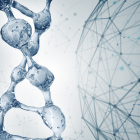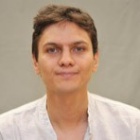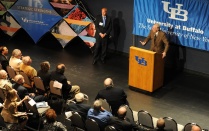NSF Research News
Genetics publishes paper by Taskent and Gokcumen on Haplotypic Variation & Deletion Polymorphisms
Genetics, published by the Genetics Society of America, contains a paper co-authored by UB alum Ozgur Taskent, a recent PhD graduate, and Omer Gokcumen,Associate Professor, Department of Biological Sciences. The work presents a comprehensive analysis of the unusually divergent haplotypes in the Eurasian genomes and showed that they can be traced back to multiple introgression events. Funded by the U.S. National Science Foundation, the research reinforces the concept that Neanderthal DNA has been woven into the modern human genome on multiple occasions as our ancestors met Neanderthals time and again in different parts of the world. Read the news article by Charlotte Hsu.
In 2019, Ozgur Taskent successfully defended his PhD thesis, "A Genetic Record of Admixture Between Humans and Ancient Hominins”, with Dr. Gokcumen serving as his advisor.
GENETICS is a scholarly society that seeks to deepen our understanding of the living world by advancing our understanding of genetics. Since 1916, GENETICS has published original research presenting novel findings bearing on genetics and genomics. The journal publishes empirical studies of organisms ranging from microbes to humans, as well as theoretical work.


Ozgur Taskent, PhD

Omer Gokcumen, PhD
Research News
Modern humans, Neanderthals share a tangled genetic history, study affirms

Results of a new story reinforce the concept that Neanderthal DNA has been woven into the modern human genome on multiple occasions as our ancestors met Neanderthals time and again in different parts of the world.
By CHARLOTTE HSU
Published April 3, 2020 This content is archived.
In recent years, scientists have uncovered evidence that modern humans and Neanderthals share a tangled past. In the course of human history, these two species of hominins interbred not just once, but at multiple times, the thinking goes.
A new study supports this notion, finding that people in Eurasia today have genetic material linked to Neanderthals from the Altai mountains in modern-day Siberia. This is noteworthy because past research has shown that Neanderthals connected to a different, distant location — the Vindija Cave in modern-day Croatia — have also contributed DNA to modern-day Eurasian populations.
The results reinforce the concept that Neanderthal DNA has been woven into the modern human genome on multiple occasions as our ancestors met Neanderthals time and again in different parts of the world.
The study was published on March 31 in the journal Genetics.
“It’s not a single introgression of genetic material from Neanderthals,” says lead researcher Omer Gokcumen, a UB biologist. “It’s just this spider web of interactions that happen over and over again, where different ancient hominins are interacting with each other, and our paper is adding to this picture. This project will now add to an emerging chorus — we’ve been looking into this phenomenon for a couple of years, and there are a couple of papers that came out recently that deal with similar concepts.
“The picture in my mind now is we have all these archaic hominin populations in Europe, in Asia, in Siberia, in Africa,” Gokcumen says. “For one reason or another, the ancestors of modern humans in Africa start expanding in population, and as they expand their range, they meet with these other hominins and absorb their DNA, if you will. We probably met different Neanderthal populations at different times in our expansion into other parts of the globe.”
Gokcumen, associate professor of biological sciences, College of Arts and Sciences, led the study with first author Recep Ozgur Taskent, a recent UB PhD graduate in the department. Co-authors include UB PhD graduate Yen Lung Lin, now a postdoctoral scholar at the University of Chicago, and Ioannis Patramanis and Pavlos Pavlidis of the Foundation for Research and Technology in Greece.
The research was funded by the U.S. National Science Foundation.
To complete the project, scientists analyzed the DNA of hundreds of people of Eurasian ancestry. The goal was to hunt for fragments of genetic material that may have been inherited from Neanderthals.
This research found that the Eurasian populations studied could trace some genetic material back to two different Neanderthal lineages: one represented by a Neanderthal whose remains were discovered in the Vindija cave in Croatia, and another represented by a Neanderthal whose remains were discovered in the Altai mountains in Russia.
Scientists also discovered that the modern-day populations they studied also share genetic deletions — areas of DNA that are missing — with both the Vindija and Altai Neanderthal lineages.
The DNA of the Vindija and Altai Neanderthals, along with the modern human populations studied, were previously sequenced by different research teams.
“It seems like the story of human evolution is not so much like a tree with branches that just grow in different directions. It turns out that the branches have all these connections between them,” Gokcumen says. “We are figuring out these connections, which is really exciting. The story is not as neat as it was before. Every single ancient genome that is sequenced seems to create a completely new perspective in our understanding of human evolution, and every new genome that’s sequenced in the future may completely change the story again.”
Faculty Profile

Omer Gokcumen
PhD
Research Interests
Human and primate evolution, ancient humans (including Neanderthals and Denisovans), anthropological genomics
Education
- PhD, University of Pennsylvania
- Postdoctoral Research, Harvard Medical School
Research Statement
Omer Gokcumen is an expert in evolutionary anthropology — the study of how humans evolved and how they differ from non-human primates such as gorillas and chimpanzees. His work is tied to human evolution, including evolutionary adaptation and the evolutionary processes that lead to genetic disease.
Gokcumen’s research examines the role that genomic variants, especially deletions and duplications, play in human disease and biology. His laboratory investigates the evolutionary history of genetic variations tied to interesting traits and diseases in modern and ancient human populations.
- 2022 Interview for BBC 4 - Inside Science on our work on evolution of mucus. (here)
- 2022 Interviewed for NPR - RadioLab. “Neanderthals’ revenge” episode on our work on ancient alleles in the human genome. (here)
- 2021 Interviewed for Scientific American on our work on the evolution of human growth hormone receptor. (here)
- 2021 Interviewed for The Scientist on our work on the evolution of human growth hormone receptor. (here)
- 2021 Quoted in How Stuff Works - “How human are humans?” by Joanna Thompson. (here)
- 2020 BBC - Reel
- 2019 Quoted in NYTimes.
- 2022 Pajic et al. A mechanism of gene evolution generating mucin function. Press release. Selected highlights: New Scientist, Yahoo News, BBC, GEN, Inverse.
- 2021 Saitou et al. Sex-specific phenotypic effects and evolutionary history of an ancient polymorphic deletion of the human growth hormone receptor. Press release. Selected highlights: Real Clear Science, The Scientist, Scientific American.
- 2020 Saiotu et al. Functional Specialization of Human Salivary Glands and Origins of Proteins Intrinsic to Human Saliva. Press release. Selected Highlights: Cosmos, CBC- Radio Active.
- 2020 Taskent et al. Analysis of haplotypic variation and deletion polymorphisms point to multiple archaic introgression events, including from Altai Neanderthal lineage. Press release. Selected Highlights: Futurity, Sputnik, Genetic Literacy Project.
Selected Publications
- Yilmaz, F., Karageorgiou, C.*, Kwondo, K., Pajic P.*, Scheer, K.*, HGSV Consortium, Beck, C., Torregrossa, A-M., Lee, C., Gokcumen, O.* (2024). Reconstruction of the human amylase locus reveals ancient duplications seeding modern-day variation. Science. 386: eadn0609
- Russel, M., Aqil, A*., Saitou, M., Gokcumen, O*, Naoki, M. (2023) Gene communities in co-expression networks across different tissues. PloS Computational Biology. 19(11): e1011616. [co-Corresponding Author].
- Veilleux, C.C., Garrett, E.C., Pajic, P.*, Saitou, M.*, Ochieng, J., Dagsaan, L.D., Dominy, N.J., Perry, G.H., Gokcumen, O.*, Melin, A.D. (2023). Veillex Human subsistence and signatures of selection on chemosensory genes. Communications Biology. 6: 683. [co-Corresponding Author].
- Aqil, A.*, Pavlos, P., Speidel, L. Gokcumen, O.* Balancing selection on genomic deletion polymorphisms in humans. (2023). eLife. e79111
- Pajic, P.*, Shen, S., Qu, J., May, A.J., Knox, S., Ruhl, S., Gokcumen, O.* (2022) A mechanism of gene evolution generating mucin function. Science Advances. 8: 34.
- Saitou, M.*, Masuda, N., Gokcumen, O.* (2022). Similarity-based analysis of allele frequency distribution among multiple populations identifies adaptive genomic structural variants. Molecular Biology and Evolution. 39: msab313.
- Saitou, M.*, Resendez, S.*, Pradhan, A.J., Wu, F., Lie, N.C., Hall, N.J., Zhu, Q., Reinholdt, L. Satta, Y., Speidel, L., Nakagome, S., Hanchard, N. A., Churchill, G., Lee, C., Atilla-Gokcumen, G. E., Mu, X., Gokcumen, O.* (2021). Sex-specific phenotypic effects and evolutionary history of an ancient polymorphic deletion of the human growth hormone receptor. Science Advances. 7, eabi4476.
- Saitou, M.*, Gaylord, E., Xu, D., Neznanova, L., Nathan, S., Grawe, A., Chang, J., Ryan, William., Ruhl, S., Knox, S.M., and Gokcumen, O.* (2020). Functional Specialization of Human Salivary Glands and Origins of Proteins Intrinsic to Human Saliva. Cell Reports. 33, 108402.
- Taskent, O.*, Yen Lung Lin, Patramanis, I., Pavlidis, P., Gokcumen, O.* (2020). Analysis of haplotypic variation and deletion polymorphisms point to multiple archaic introgression events, including from Altai Neanderthal lineage. Genetics. 215: 497-509.
- Pajic, P.*, Pavlidis, P., Dean, K., Neznanova, L., Daugherity, E., Romano R-A., Garneau, D., Globig, A., Ruhl, S., Gokcumen, O.* (2019). Independent amylase gene copy number bursts correlate with dietary preferences in mammals. eLife.
- Lin, Y.-L.*, & Gokcumen, O.* (2019). Fine-Scale Characterization of Genomic Structural Variation in the Human Genome Reveals Adaptive and Biomedically Relevant Hotspots. Genome Biology and Evolution, 11(4), 1136–1151.
- Saitou, M.*, Lizardo, D., Taskent, R. O.*, Millner, A., Gokcumen, O.*, Atilla-Gokcumen, G. (2018). An evolutionary transcriptomics approach links CD36 to membrane remodeling in replicative senescence. Mol Omics 14, 237 [Cover article, co-Corresponding Author].
- Xu, D.*, Pavlidis, P., Taskent*, R.O., Alachiotis, N., Flanagan. C.*, DeGiorgio, M., Ruhl, S., Gokcumen, O.* (2017). Archaic hominin introgression in Africa contributes to functional salivary MUC7 genetic variation. Mol Biol Evol. 34: 2704

